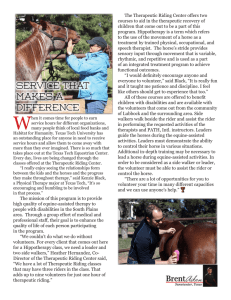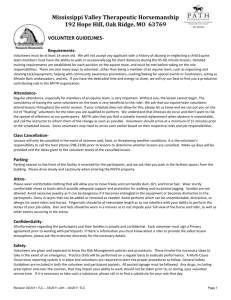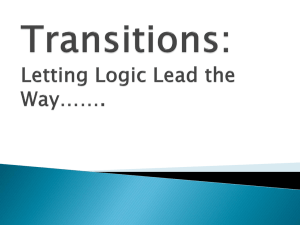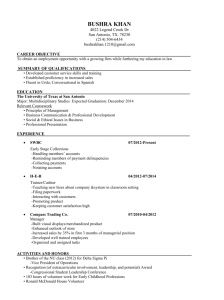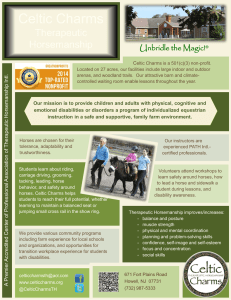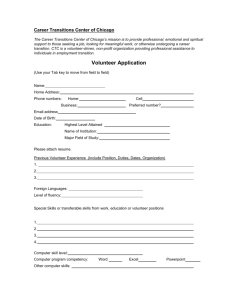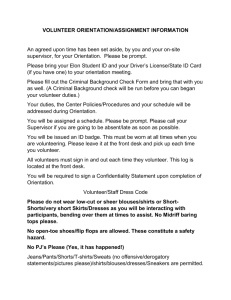Mississippi Valley Therapeutic Horsemanship 192 Hope Hill, Oak
advertisement
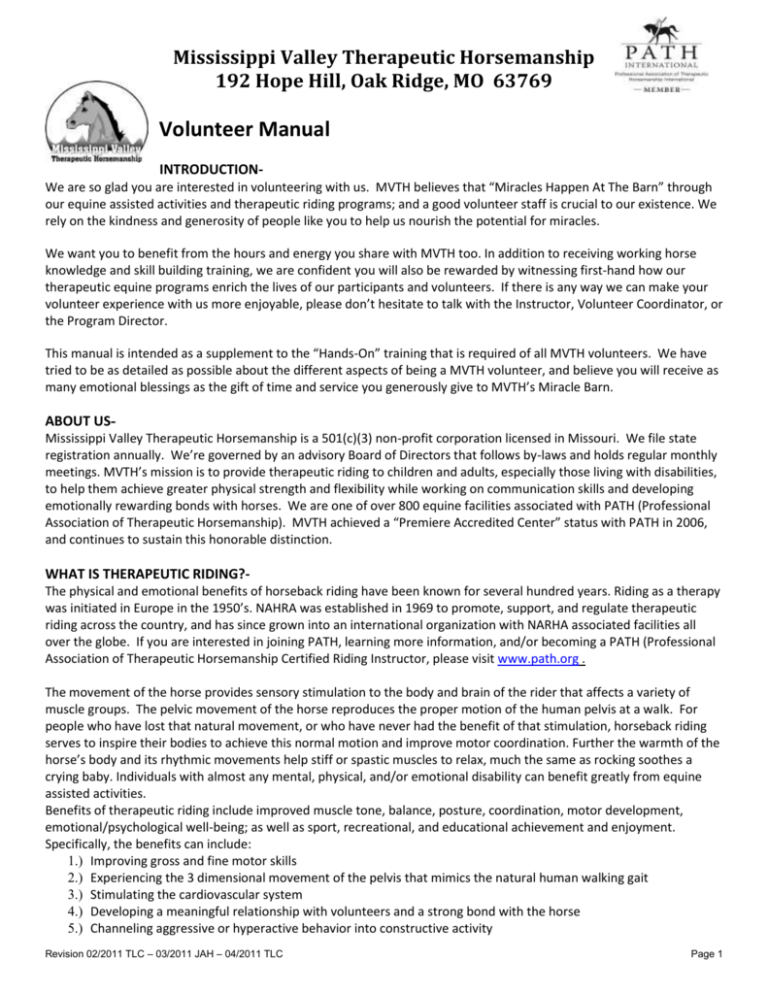
Mississippi Valley Therapeutic Horsemanship 192 Hope Hill, Oak Ridge, MO 63769 Volunteer Manual INTRODUCTIONWe are so glad you are interested in volunteering with us. MVTH believes that “Miracles Happen At The Barn” through our equine assisted activities and therapeutic riding programs; and a good volunteer staff is crucial to our existence. We rely on the kindness and generosity of people like you to help us nourish the potential for miracles. We want you to benefit from the hours and energy you share with MVTH too. In addition to receiving working horse knowledge and skill building training, we are confident you will also be rewarded by witnessing first-hand how our therapeutic equine programs enrich the lives of our participants and volunteers. If there is any way we can make your volunteer experience with us more enjoyable, please don’t hesitate to talk with the Instructor, Volunteer Coordinator, or the Program Director. This manual is intended as a supplement to the “Hands-On” training that is required of all MVTH volunteers. We have tried to be as detailed as possible about the different aspects of being a MVTH volunteer, and believe you will receive as many emotional blessings as the gift of time and service you generously give to MVTH’s Miracle Barn. ABOUT USMississippi Valley Therapeutic Horsemanship is a 501(c)(3) non-profit corporation licensed in Missouri. We file state registration annually. We’re governed by an advisory Board of Directors that follows by-laws and holds regular monthly meetings. MVTH’s mission is to provide therapeutic riding to children and adults, especially those living with disabilities, to help them achieve greater physical strength and flexibility while working on communication skills and developing emotionally rewarding bonds with horses. We are one of over 800 equine facilities associated with PATH (Professional Association of Therapeutic Horsemanship). MVTH achieved a “Premiere Accredited Center” status with PATH in 2006, and continues to sustain this honorable distinction. WHAT IS THERAPEUTIC RIDING?The physical and emotional benefits of horseback riding have been known for several hundred years. Riding as a therapy was initiated in Europe in the 1950’s. NAHRA was established in 1969 to promote, support, and regulate therapeutic riding across the country, and has since grown into an international organization with NARHA associated facilities all over the globe. If you are interested in joining PATH, learning more information, and/or becoming a PATH (Professional Association of Therapeutic Horsemanship Certified Riding Instructor, please visit www.path.org . The movement of the horse provides sensory stimulation to the body and brain of the rider that affects a variety of muscle groups. The pelvic movement of the horse reproduces the proper motion of the human pelvis at a walk. For people who have lost that natural movement, or who have never had the benefit of that stimulation, horseback riding serves to inspire their bodies to achieve this normal motion and improve motor coordination. Further the warmth of the horse’s body and its rhythmic movements help stiff or spastic muscles to relax, much the same as rocking soothes a crying baby. Individuals with almost any mental, physical, and/or emotional disability can benefit greatly from equine assisted activities. Benefits of therapeutic riding include improved muscle tone, balance, posture, coordination, motor development, emotional/psychological well-being; as well as sport, recreational, and educational achievement and enjoyment. Specifically, the benefits can include: 1.) Improving gross and fine motor skills 2.) Experiencing the 3 dimensional movement of the pelvis that mimics the natural human walking gait 3.) Stimulating the cardiovascular system 4.) Developing a meaningful relationship with volunteers and a strong bond with the horse 5.) Channeling aggressive or hyperactive behavior into constructive activity Revision 02/2011 TLC – 03/2011 JAH – 04/2011 TLC Page 1 Mississippi Valley Therapeutic Horsemanship 192 Hope Hill, Oak Ridge, MO 63769 6.) Increasing ability to follow direction 7.) Improving memory utilization 8.) Developing sequencing abilities 9.) Increasing verbal and nonverbal communications 10.) Recognition of the effects of participant’s personal emotional attitude by the mirroring of actions in the horse There is another huge benefit that is more difficult to measure, but easy to see in the rider’s self-identity. When a participant who utilizes a wheelchair or crutches, becomes taller as mounted on the back of a horse, they no longer have to look up at everyone. Imagine how the rider’s confidence and self-esteem grows from having control of such a large animal that responds to their direction! In the real world, their disability is always at the forefront…. But on the back of the horse, a rider’s disabilities become “invisible”, giving them the wonderful feeling of freedom, accomplishment, and instantaneous reward. What documentation will I need to complete and submit in order to be an MVTH volunteer? We are required to have several forms on file for each volunteer/staff member prior to their volunteer service: 1.) Volunteer/Staff Information & Health History Form- Includes consent for Photo Release and Background Check 2.) Missouri State Background Check Form 3.) Authorization For Emergency Medical Treatment 4.) Liability Release 5.) Privacy Policy 6.) Disability Orientation Once a volunteer has started training in our volunteer programs, MVTH will keep a record of the training received, job roles skill-tested to perform, and the number of volunteer hours served. Questions?Ideas?Suggestions? If you would like to discuss MVTH Volunteer programs and opportunities, please feel free to call or email Jerre Hall, Volunteer Coordinator, at (573) 270-1640 or jerrehall@charter.netor Mary Ann Mann, Program Director, at (573)5794373 or maryannmann@hotmail.com Thank you for your interest and we look forward to working with you! Jerre Hall Revision 02/2011 TLC – 03/2011 JAH – 04/2011 TLC Page 2
